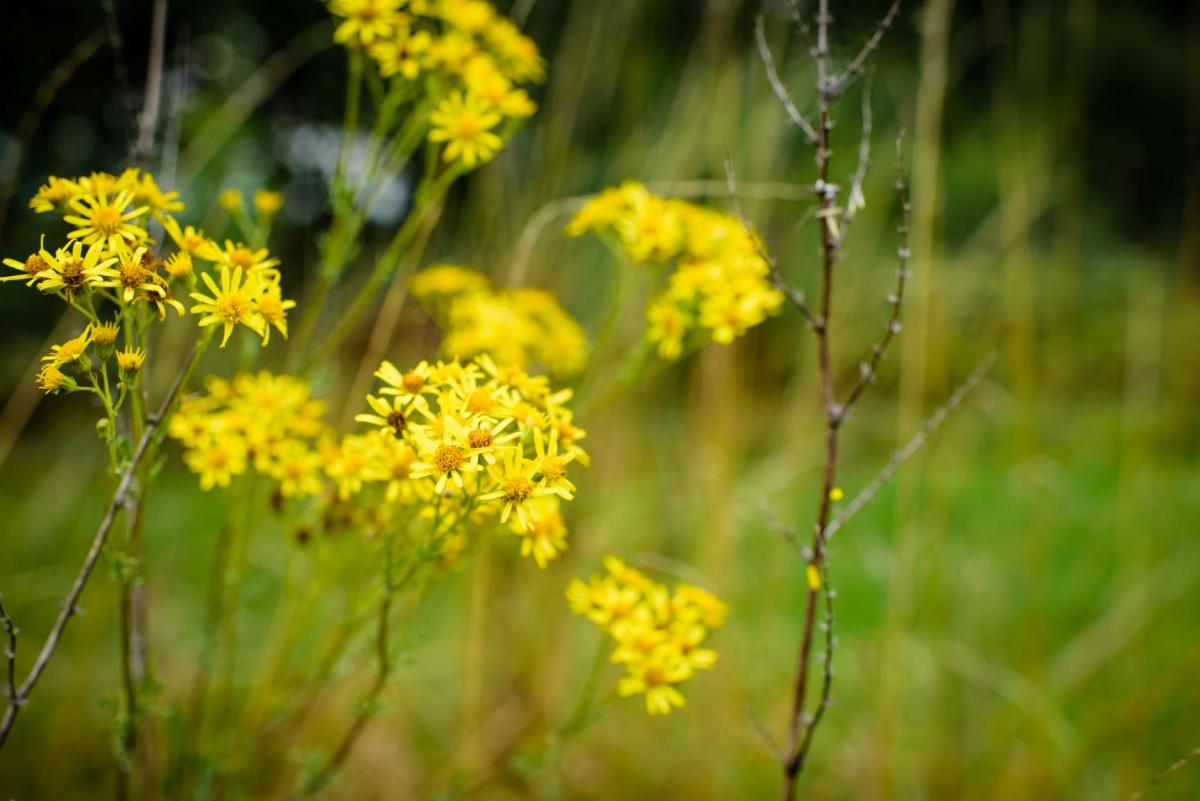
Ragwort – what is it and why is it in the Forest?
A naturally occurring wildflower, the Forest recognises the important part ragwort plays in increasing biodiversity. However, it is a poisonous weed and people particularly have concerns around its potential toxicity to horses and livestock. in the Forest, we believe in controlling ragwort as needed so that biodiversity benefits from this valuable plant.
What is ragwort?
A delicate plant, with its spray of golden-petalled flowers, ragwort flowers from June until November. It has deeply cut and toothed leaves giving a ragged appearance from which the plant derives its name.
It is a biennial and an opportunist, readily colonising patches of bare ground. It can be found within our young planting (although it does diminish as the canopy closes) and at the edges of the Forest, and is also very common along roadside verges.
It is a late flowering, nectar-rich wildflower and therefore very important for pollinators. One out of every three mouthfuls of our food depends on pollinators, which have suffered disastrous declines over recent years.
Why is it important
Ragwort provides a home and source of food to a large number of insect species including bees, butterflies, moths and other insects, 30 of which rely on the plant as its sole food source and 10 of which are so rare they are on the IUCN Red List. These include the picture winged fly, the scarce clouded knot horn moth, and the Sussex emerald moth
Another moth that relies on ragwort for its survival is the brightly-coloured cinnabar moth and it has a specific different reason for this reliance. Ragwort contains several naturally occurring chemical compounds known as alkaloids. These alkaloids can be poisonous to some animals but cinnabar moth caterpillars feed on ragwort, ingesting these alkaloids, which then make them extremely unpalatable to predators.
Common ragwort is one of the most frequently visited flowers by butterflies in the UK and more than 200 species of invertebrate have been recorded on it.
Controlling ragwort
Three species of ragwort are found in the Forest, each to varying degrees: common, hoary, and Oxford ragwort. Whilst the first two are natives, the third was introduced from Sicily by Oxford University botanists during the 16th century. Of these, we recognise that because common ragwort can grow in abundance it needs controlling where appropriate, and we do so in line with Defra’s code of practice.
Sometimes known as the scourge of horse owners because of its potential toxicity to their animals, ragwort is, in fact, only likely to be harmful to them when ingested by them in its dried form (horses normally steer clear of the bitter taste of it in its natural form). It is, therefore, essential to control ragwort if the pasture is being cut for hay.
As the Heart of England Forest is also an established organic livestock farmer as part of its work growing the forest, we understand why people are concerned about the health and welfare of their animals, which often provide their livelihood.
Around the Heart of England Forest responsible management means that steps are taken to control it where appropriate as part of our routine woodland maintenance schedule, particularly when we are notified that it is within 100 metres of pasture land, in line with Defra guidance. As an environmental charity, the Heart of England Forest does not use chemicals for control, but instead uses mechanical methods to prevent the plant from seeding and spreading.
Responding to concerns about ragwort
When we are advised by a neighbouring land owner that common ragwort is growing in the Forest close to their pasture land or hay meadow, we carry out an inspection to assess the risks and take appropriate action. We encourage anyone who has a concern regarding ragwort to address them to the charity, so that we can work together to resolve any issues. Please email info@heartofenglandforest.org and share a map of the pasture land in question, as this will enable us to identify it quickly and take swift action.
A balancing act
While ragwort can be a contentious subject, and it is easy to dismiss it as ‘just another weed’, it clearly plays an important role in the ecosystem. Without it many species might be lost forever. We believe that there is a balance that can be struck, where ragwort is controlled as needed whilst biodiversity benefits from this valuable plant.
* https://www.wildlifetrusts.org/wildlife-explorer/wildflowers/common-ragwort



